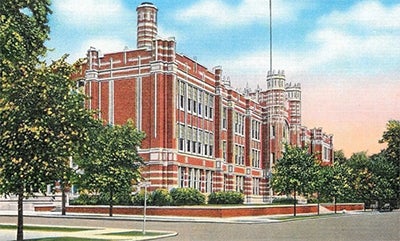Celebration this weekend for AHS’ north side
Published 7:23 pm Tuesday, April 19, 2022

- Photo of Austin High School’s north building. Drone photo taken by Paul Hunter of the Mower Soil and Water Conservation District.
|
Getting your Trinity Audio player ready...
|
Big events typically start with the singing of the “Star Spangled Banner.”
Nearly 100 years ago, however, the song came at the end of a Friday night dedication ceremony for Austin’s new high school building in its auditorium (today’s Christgau Hall).
This song closed out the Dec. 9, 1921, celebration by the community that overwhelmingly supported constructing the nearly $1 million Gothic Revival edifice — nearly $14.8 million in today’s dollars — for grades 7–12. The Minneapolis Morning Tribune called it the “third-largest high school in the United States” featuring 275 rooms; an auditorium for about 1,200; a state-of-the-art swimming pool; a gymnasium; a large cafeteria; and a library with a fireplace.
After two years of work, Austin put itself on the map as a community that valued education.
On Saturday, April 23, the Austin High School Alumni & Friends Association will join the Austin Public Education Foundation in hosting an open house from 10 a.m. to 2 p.m. for the “old part” of the high school. This event is focused on the 100th anniversary of Austin High’s north end opening for its first school year.
This free open house will offer tours of the school, a movie in Knowlton Auditorium on the school’s history, other activities and cookies.
Dr. J.M. McConnell, commissioner of education for the State of Minnesota, spoke at the December 1921 dedication.
That morning, after a U.S. flag was hoisted up the school’s new, steel flagstaff, students attended a day of classes before the building — more commonly called Central High School — was opened to visitors to wander and “marvel in wonderment at progress over the ‘Little Red Schoolhouse’ of their childhood days,” the Mower County News wrote.
More than 2,000 people — the city had 10,000 — went through the school that afternoon for their “first glimpse of the handsome new structure which is to be the education Mecca of the youth of Austin and Mower County for many years to come.

Postcard of Austin High’s north section (likely 1930s). Photo provided
Crowded classes lead to project
In February 1919, the Austin School Board unanimously decided a new high school building should be built “as soon as possible to relieve the congested condition,” the Mower County Transcript-Republican reported.
Austin was finishing up a decade that saw it grow by 45 percent; overall the district had 72 more students than a year earlier.
District officials did a “careful investigation of the seriously crowded condition” of the schools, especially Franklin School, then the high school on the south half of where Austin High now stands.
“Every school in the city is overcrowded,” stated the Feb. 12, 1919, article. “Districts have had to be changed, and some children are obliged to go long distances to school on account of the crowded condition.”
Four months later, voters approved a bond issue not to exceed $450,000 by an overwhelming vote of 726–75 in a Saturday special election that did not draw as large of a turnout as expected.
G.L. Lockhart, a St. Paul architect and engineer who wrote a 1918 book about building public schools, was chosen to design it.
District officials made room for the new school by razing the three-story Washington elementary school, which was just 12 years old but had bad heating and was in poor condition. Some homes also were removed.
Demolition began in October 1919. In July 1920, officials laid the cornerstone, a “large block of Bedford cut stone, inscribed with AD 1920.”
‘Second to none’
When the school opened Sept. 12, 1921, the News called it “second to none in Minnesota.”
“It is not only one of the largest but also is one of the best from an architectural standpoint,” the News wrote.
Local and regional newspapers differed in the school’s total cost. Listings were for “well over half million” to a “million-dollar school” to $1,125,000 to $1,250,000.
The auditorium (Christgau Hall) boasted a main floor, large balcony extending around three sides and a stage that was “unusually large and affords ample room for the many high school productions.” Plans for the auditorium also included hosting student assemblies, mass meetings, and other community functions.
In the 1922 Austinian, the auditorium was called “a beautiful room, artistically lighted, fully equipped in every detail. It is the ideal place for general assembly and entertainment. The stage is very large and the scenery and stage sets varied and beautiful. A Steinway Grand piano is the crowning feature of the auditorium.”
On the first floor, rooms mainly were for the sciences, including physics, chemistry, botany, zoology, general science and agriculture. It also had rooms for manual arts, such as manual training and shop work, and the commercial department for typewriting, shorthand, bookkeeping and other subjects.
A large conservatory on the south side was available for botany classes and agriculture.
Older students occupied the second floor, the junior-high kids were on third floor with both using the first floor for sciences and vocational subjects. Both second and third floors had two study rooms for 80 students.
A swimming pool — 90 feet by 22 feet — was “one of the largest in the state” and ranged from 4 to 8 feet deep. Its water was purified by the “best of modern systems, known as the ultra-violet ray method.”
The gym floor (where the library is now) wasn’t completed, and the basement cafeteria was not ready for use in the 1921–22 school year. Part of the building’s west wing was left open for a possible junior college.
Also, the library opened the following school year with a fireplace, tables, chairs and 200 volumes of books.




